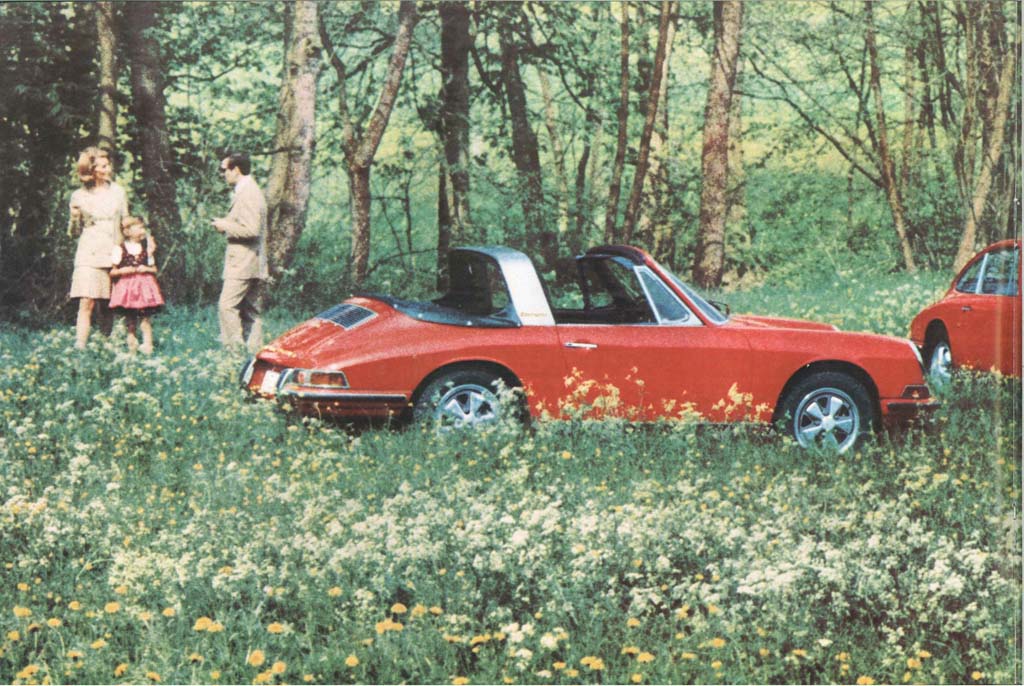
Porsche 911 Targa - 1968
.jpg)
The 1996 Porsche Carrera Targa®, an exciting new addition to the 911 model series, features a unique sliding glass roof with sun visor and wind deflector. Virtually the entire roof area over the passenger compartment slides under the rear window, providing an open-air feeling much greater than that of a Coupe with an open sunroof.
.jpg)
The roof glass, tinted for privacy and to keep out ultra-violet rays, slides quietly and smoothly under the rear glass for open-air motoring. For additional privacy and sun blockage, a roller blind can be electrically deployed from its compartment in the roof lining above the windshield. The wind deflector is electrically adjustable throughout its tilt range. Open or closed, the Porsche Targa retains the familiar 911 silhouette, while incorporating recent aerodynamic, structural and safety refinements. Key features are its welded, unitized body of double-sided zinc-galvanized steel, speed-dependent extendible rear spoiler, tinted glass, second-generation side-impact protection, heated windshield washer nozzles, fog lamps incorporated into the front spoiler and modular polyellipsoid headlights with washer system. Optional for 1996 are "Litronic" gas-discharge headlamps.
.jpg)
The new model evolved from the original Targa introduced by Porsche in 1965 when proposed regulations threatened the extinction of convertible cars. Porsche engineers found this unacceptable and developed the open-air Porsche Targa roof. Porsche Targa models through 1994 sported a removable roof panel above the passenger compartment, supported in the front by the windshield header and in the rear by wide "B"-pillars and the rear roof section. Some models had flexible, folding rear windows; others had solid glass with a rear defroster. While renewed interest in convertibles during the 1980s provided a rejuvenation for the 911 Cabriolet, the unique design of the 911 Targa had established its own solid market, so Targa production was also continued. To meet the demands of Targa clientele, Porsche engineers have now designed a new version which combines fully automated top operation with sleek 911 looks. Below the window line, the 1996 Porsche Carrera Targa shares its body and platform with the 911 Carrera Cabriolet, including additional reinforcement for structural rigidity. The roof module, which resembles the Coupe in profile, consists of two-layer laminated safety glass, sun visor, wind deflector, rear window and aluminum frame.
.jpg)
The Porsche 911 Carrera Targa is powered by Porsche's traditional 3.6 liter, air-cooled, six-cylinder, 282 horsepower (210 kW) boxer engine. Last year's engine redesign already resulted in a nine percent increase in power without any fuel economy penalty while meeting stringent emission standards. The modest rise in this year's overall numbers masks the real story-a solid boost in the engine's mid-range torque pattern.
.jpg)
The primary means of achieving this improvement was enhancement of Porsche's Varioram™ induction system. The Varioram system optimizes volumetric efficiency for high torque output, resulting in quick throttle response and strong acceleration Using variable-length intake pipes and separate, differently tuned air intake systems for medium and high engine speeds, torque and power output characteristics are optimized across the entire usable engine speed range. Inlet and exhaust valves are larger, camshafts with modified valve timing and an optimized ignition system have been adopted.
All 1996 Porsche 911 models feature a new system for monitoring all componente with exhaust emission control relevance. While the car is being driven, the OBD II (en-beard diagnostics, second generation) system measures the efficiency of the catalytic converter. identifies misfiring, and monitors the functions of the fuel system, fuel tank venting. secondary-air injection, oxygen sensors and other components and systems which affect exhaust emissions. 1996 Porsche 911 models can be visually distinguished by their new "D"-shaped tailpipes.
.jpg)
The 1996 Porsche Carrera Targa can be ordered with either a six-speed manual or four speed Tiptronic S automatic transmission. Like other 911 models, the Targa has a hilly independent suspension. The semi-trailing arms and struts of previous 911s have been replaced by Porsche's Lightweight-Stable-Agile (LSA) multi-link subframe-mounted rear suspension system. Superior braking, long a Porsche trademark, continues with the Targa. Internally vented cross-drilled rotors, four-piston calipers and asbestos-free pads are augmented by the latest Bosch ABS 5 anti-lock braking system. The 1906 Porsche 911 Carrera Targa comes equipped with Targa-style pressure-cast aluminum alloy 17-inch wheels (seven inches wide in the front, nine inches wide in the rear) mounted with 205/50 front and 255/40 rear tires.
The 1996 Porsche 911 Carrera Targa interior features Porsche's traditional 2+2 seating package with its familiar look and operation, including five round analog gauges and ignition switch to the left of the steering wheel. Interior equipment includes standard partial leather seats, dual front airbags, three-point restraints for driver and all passengers and AM/FM/cassette audio system, among other elements.
.jpg)
Every new Porsche sports car is covered by a two-year bumper-to-bumper limited warranty with unlimited mileage, including Porsche's roadside assistance program. The galvanized body and 26-step paint and anti-corrosion process enable Porsche to warrant each ear against rust perforation for ten years and unlimited mileage. In addition, the paint has a three year limited warranty.
.jpg)
.jpg)
.jpg)

Porsche 911 Targa - 1968
.jpg)
Porsche 911 Targa - 1997

Porsche Press kit

Porsche Literature

Our Porsche Cars